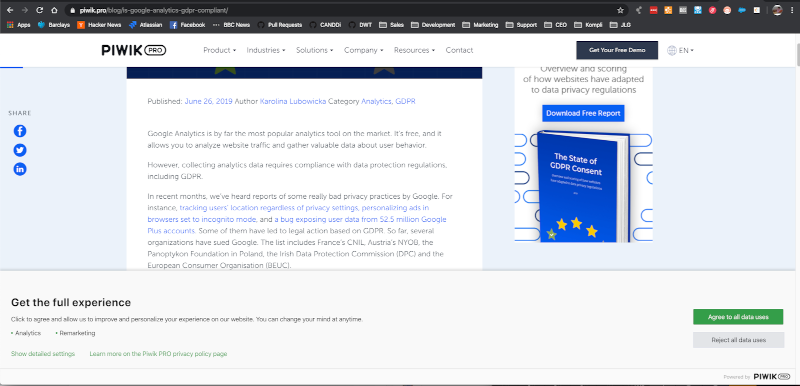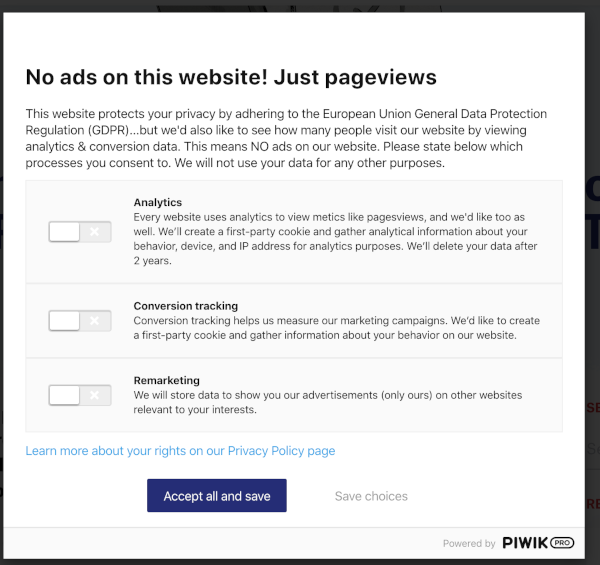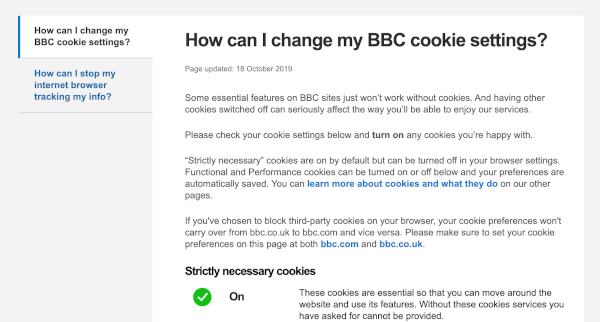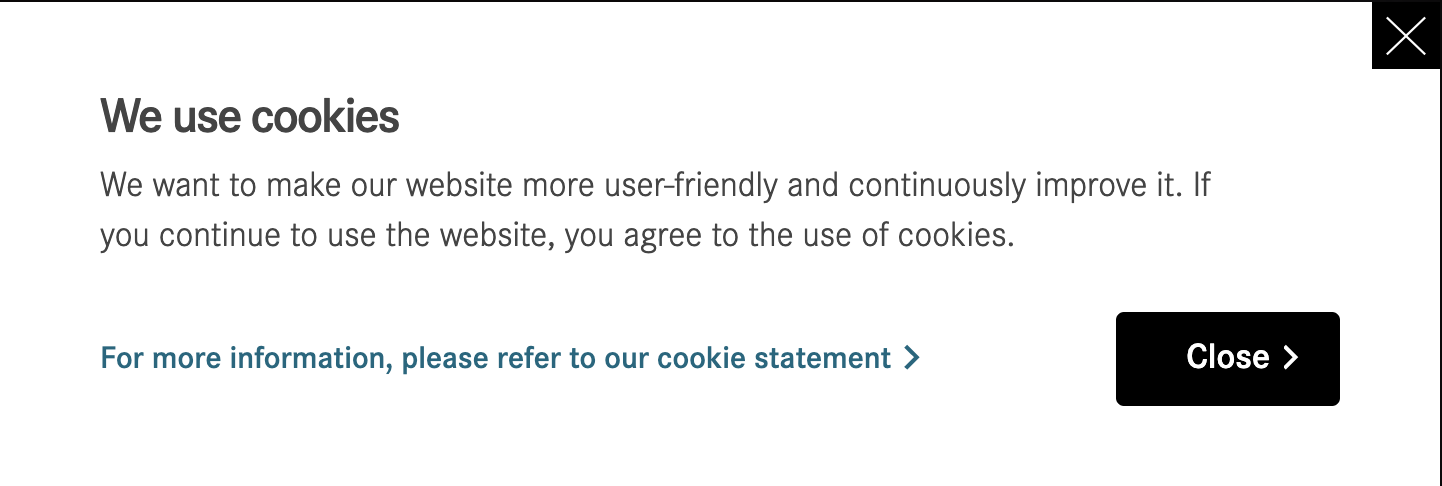Support > Legal > Cookies and the Law: Everything You Need To Know
Cookies and the Law: Everything You Need To Know
While the value of businesses tracking their website visitors is clear, the law on how to demonstrate the legal basis for this tracking is a constantly evolving topic.
It’s important for businesses to strike the right balance: you want to place cookies on as many of your visitors’ devices as possible in order to optimize their experience, but you also must ensure they have provided sufficient consent in the eyes of the law.
We’re certainly not lawyers - and the responsibility for implementing tracking consent mechanisms for your visitors rests on your shoulders - but we’ve put together a guide to give our expert opinion and push you in the right direction.
We’ll cover the different types of cookie banners, explain some of the jargon, and lay out what the law says when it comes to consent.
Let’s get started!
Glossary
First-party cookies
These cookies can ONLY be placed and read from the website the user is actively visiting. For example, since you’ve visited canddi.com, information about your browsing activity can only be accessed by canddi.com. This is generally used for website analytics, or to personalize the experience for the visitor.
CANDDi has always used first party tracking exclusively, so our platform isn’t in any danger of being affected by upcoming data privacy laws which tend to focus on third-party tracking.
Third-party cookies
These cookies can be read across multiple websites. Ever looked at a nice pair of trainers on asos.com, then seen ads for the same trainers on different websites across the web? Third party cookies are how this happens, and have probably wreaked havoc on your wallet over the years.
GDPR
The General Data Protection Regulation (GDPR) is a set of EU regulations which require companies (or any data controller) to be clear about the data they are processing about any data subject.
Since the nation states of the EU implement these laws separately, differing interpretations (especially in regards to what constitutes “informed consent” and “legitimate interest”) have led to inconsistencies in the enforcement of GDPR.
The legislation is not (by itself) concerned with tracking, or indeed the actual mechanism of data capture. Rather, it’s more concerned about a data subject’s (your visitors’) ability to access, amend, and control their data, and the legal basis under which a data controller (you) chooses to capture and use this data.
In short: what data are you capturing, and why are you holding it?
PECR
The Privacy and Electronic Communications Regulations is UK law (based off an EU directive) which concern how an organisation can electronically communicate with an individual.
Special category data
Special category data is defined as part of the GDPR. Specifically, it refers to data which is sensitive and should be controlled more carefully.
This includes (but is not limited to) items such as
- Health data
- Criminal convictions
- Data regarding any child aged under 13
GDPR is clear that any Special Category should only be handled with explicit consent.
What does the law say about cookie tracking?
At the time of writing, there is very little legal guidance regarding what online tracking compliance should look like in practice. In the UK this falls between the following legislations:
- GDPR - (https://en.wikipedia.org/wiki/General_Data_Protection_Regulation)
- PECR - (https://en.wikipedia.org/wiki/Privacy_and_Electronic_Communications_(EC_Directive)_Regulations_2003)
It’s thought that the upcoming ePrivacy Regulation will clear up most of the confusion, however this has been repeatedly pushed back and there is no current date for it’s final implementation.
Current references (correct as of 2022) from the ICO:
The PECR states that the user of that terminal equipment
- Is provided with clear information about the purposes of storage, or access to, that information; and
- Has given his or her consent
Confusingly, there is no definition given in PECR of what consent actually means. Under GDPR, however, it has the following specific definition:
“any freely given, specific, informed and unambiguous indication of the data subject’s wishes by which he or she, by a statement or by a clear affirmative action, signifies agreement to the processing of personal data relating to him or her”
If you’re still wondering just how unclear the law is on all of this, the fact that even the ICO’s compliance guide advises you “to look at the methods other online services already use” for inspiration pretty much says it all.
So, let’s look at what options are available to you.
Different types of consent forms
Regardless of the gaps in legislation, one thing is clear: some kind of consent form is required in order to track individuals online.
We believe there are four broad categories of consent forms, for each of which we’ve provided an example as well as advantages and disadvantages.
Full explicit consent
This is the whiter-than-white approach. The site displays a consent pop-up with all of the tracking options unticked. This means that if the user just simply presses “okay”, no tracking will be performed.

Here is an example from https://www.cookiebot.com/en/:
In this example, nothing is ticked by default. The user has equal ability to select “Allow selection” (no cookies by default) or “Allow all cookies”.
Positives
- The website can confirm beyond all doubt that any consent is informed and freely given
- This is a perfect option for special category data which must be handled with extra care
Negatives
- Users are likely to either be confused, or simply not read the banner and opt for no tracking. This means their activity can not be personalized or tracked, helping neither the visitor or the business.
Full implicit consent
This method provides only two main options: “accept everything” or “reject everything”.
Clearly, the user will be steered towards the green “accept everything” button, though it’s very easy for data-conscious individuals to open up a more detailed interface to explicitly opt in to different types of tracking.
Here is an example from https://piwik.pro/:


The first image shows the initial banner, while the second shows the more detailed window available to those who want it.
Positives
- Provides a privacy-aware user with the ability to select precisely what they want to consent to
- Provides the average user an ability to say yes and get on with browsing the site
- Allows the user to change their preferences at a later time
Negatives Since most users will simply click the big green button without fully reading the form, it can be argued that this does not provide explicit informed consent. As such, this isn’t suitable for websites which handle special category data.
Aggregate implicit consent with website settings
This option is a little more subtle than the full implicit consent banner.
Here, the user simply has an option to say yes; if they want to find out more they can go to a settings page (note: there isn’t a “no” option on the main banner).
This is the approach that the BBC takes, as you can see below:



It takes three clicks to navigate to the second window. Needless to say, this means it isn’t particularly easy to change which tracking you consent to, or indeed to opt-out of the cookies altogether.
Positives
- Very simple for users to opt-in
- Flexible options do exist for privacy-conscious individuals
Negatives It can be argued that the relatively hard-to-find options window actually obfuscates the entire consent process. This option is certainly not suitable for websites which handle special category data.
Aggregate implicit consent with browser settings
With this approach, the cookie consent banner contains an “accept” button and appears when the visitor first lands on a website. There is a link to that website’s privacy page for those who want to learn more about the nature of the tracking being used.
The key thing to note here is that the only way a visitor can opt out of this tracking is by clearing the cache on their browser.
The below example is from Daimler:

Note: anyone who clicks the option for more information will get sent to Daimler’s privacy page, but the banner will not disappear until they click “close”.

Positives
- Avoids all of the messiness of users having to choose the cookies they want
Negatives
- It would be hard to justify that a user has actually given informed consent. This is especially true if, like Daimler, you force the user to accept before allowing them to access the website.
Other potential risks
So we’ve established that it’s important to be aware of the legal implications of how you choose to acquire tracking consent. But it’s also important to be aware of how the technical implementation of this choice can factor in.
For example, a well known consent plugin for wordpress websites was recently found to have a major bug which meant it may not have been correctly capturing users’ consent. This not only renders the entire consent process useless, but also opens up websites to data privacy litigation.
What does CANDDi recommend?
Clearly, tracking consent currently exists in what can only be described as a very large and very gray area of the law. As such, it’s important that you determine your own approach to gathering consent on your website.
That said, we can certainly recommend that any organisation which processes any form of special category data must obtain full explicit consent.
As for typical B2B businesses, the full explicit consent approach is likely overkill. While it’s true that regulations may change in the future, there’s no need to prematurely jump to the “whitest” solution possible. We’ve seen the negative effects of this already, when thousands of B2B organisations destroyed their perfectly viable email lists in the mistaken belief that the then-upcoming GDPR legislation would make them unusable.
Keeping all of this in mind, we’d recommend most of our customers offer aggregate implicit consent with website settings. This balances the interests of the user and the interest of your company, leading to informed consent which benefits both parties and improves the relationship between them.
Click here to download the pdf version of this guide